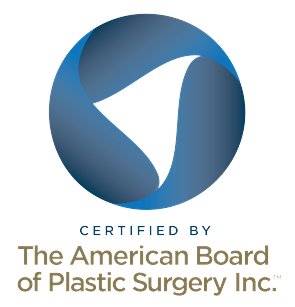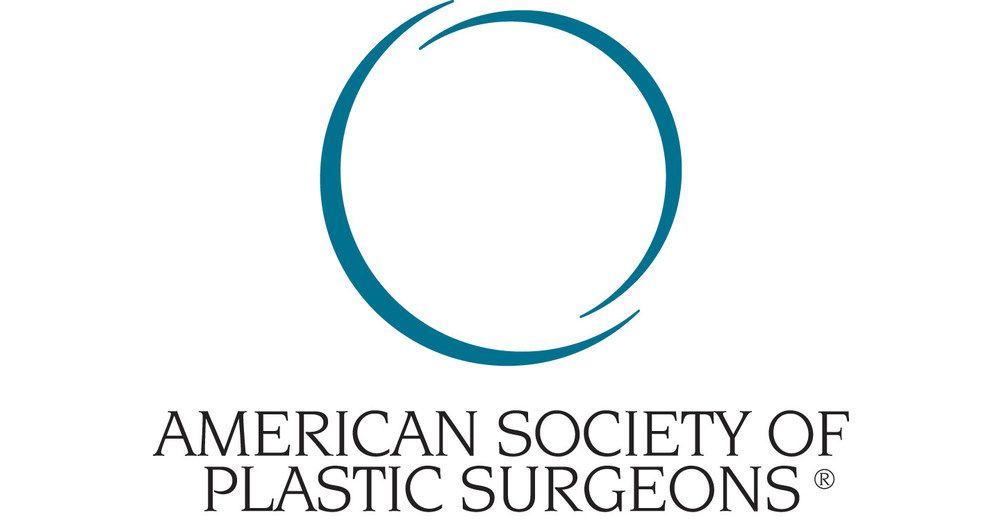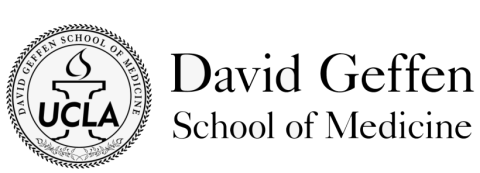BREAST RECONSTRUCTION SURGERY GLENDALE
THE PREFERRED BREAST RECONSTRUCTION &
REVISION SPECIALIST OF GLENDALE
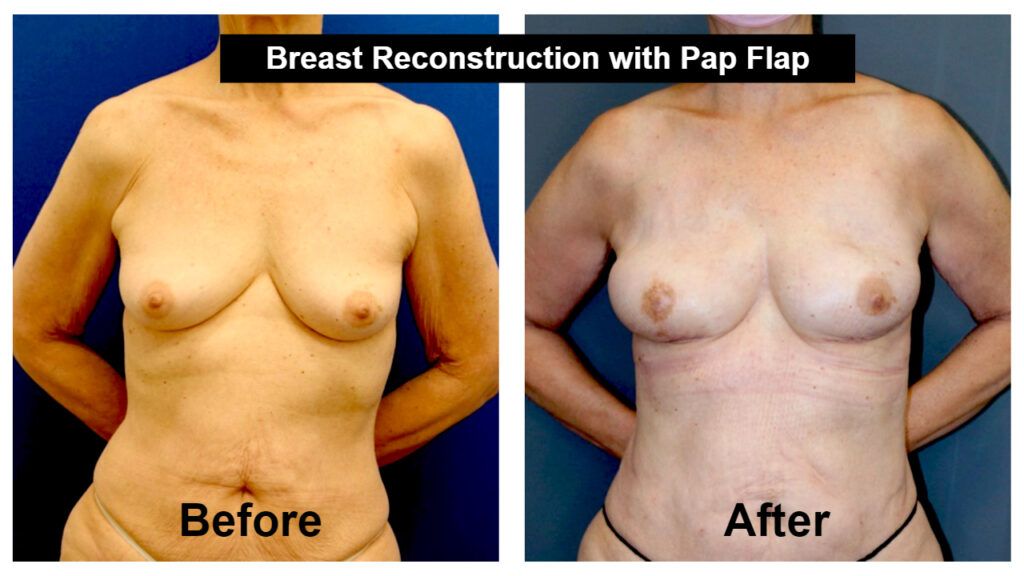
WHY CHOOSE DR. GOLDBERG AS YOUR BREAST RECONSTRUCTION SURGEON?
Dr. Goldberg is a board-certified plastic surgeon whose passion is to empower women with the most advanced breast reconstruction techniques available. As a plastic and reconstructive surgeon in Beverly Hills, she uses the latest microsurgery techniques to achieve natural results and restore your pre-mastectomy breast shape. No matter where you’re at on your journey or what type of reconstruction you desire in Beverly Hills, Santa Monica, or the greater Los Angeles area, Dr. Goldberg looks forward to enhancing your physical and mental well-being so you can feel confident and beautiful.
AM I A CANDIDATE FOR BREAST RECONSTRUCTION?
Candidates for breast reconstruction surgery in Beverly Hills, Santa Monica, and the greater Los Angeles area might have:
- Undergone a mastectomy or lumpectomy to treat breast cancer
- Undergone a prophylactic mastectomy due to an inherited genetic mutation (in the BRCA1 or BRCA2 gene) that predisposes them to breast cancer
- Congenital breast deformities they would like corrected
- Breast reconstruction after explantation due to BII (Breast Implant Illnesses)
While breast reconstruction after mastectomy is most common, transgender patients can also be candidates for breast reconstruction surgery. This procedure can allow them to affirm their authentic selves and have their appearance more closely match their identity.
BREAST RECONSTRUCTION PATIENTS SHOULD HAVE:
- A positive outlook for restoring their breasts
- A clear understanding of the procedural limitations and capabilities
- No additional medical conditions that could cause procedure complications
- No need for further cancer treatments before undergoing this procedure

BY UNDERSTANDING THE CHOICES FOR BREAST RECONSTRUCTIONS, A WOMAN IS EMPOWERED IN HER FIGHT AGAINST BREAST CANCER.
WHAT HAPPENS AT A BEVERLY HILLS BREAST RECONSTRUCTION CONSULTATION?
During your initial Beverly Hills plastic surgery consultation, Dr. Goldberg will discuss your concerns regarding the state of your breasts and your surgical goals. After evaluating your health and examining your breasts, she will explain your options for breast reconstruction. She will then make recommendations for your treatment strategy and help you decide what is best for you.
Dr. Goldberg might work with your oncologist(s) to form a surgical plan that is oncologically sound. This ensures that your Beverly Hills and greater Los Angeles breast reconstruction is not only emotionally empowering and aesthetically pleasing but supportive of your overall health.
HOW IS BREAST RECONSTRUCTION SURGERY PERFORMED?
Dr. Goldberg provides a wide selection of breast reconstruction procedure options using the latest techniques in microsurgery. By understanding the options available for breast reconstruction, women can feel encouraged in their fight against breast cancer and other breast deformities.
Breast reconstruction can be performed either in a single stage (surgery) at the same time as mastectomy or as 2 or more stages with multiple surgeries. Patients also have the option of delayed reconstruction, where they can undergo treatment to restore their breasts at a later time, often after they are finished with their cancer treatments.
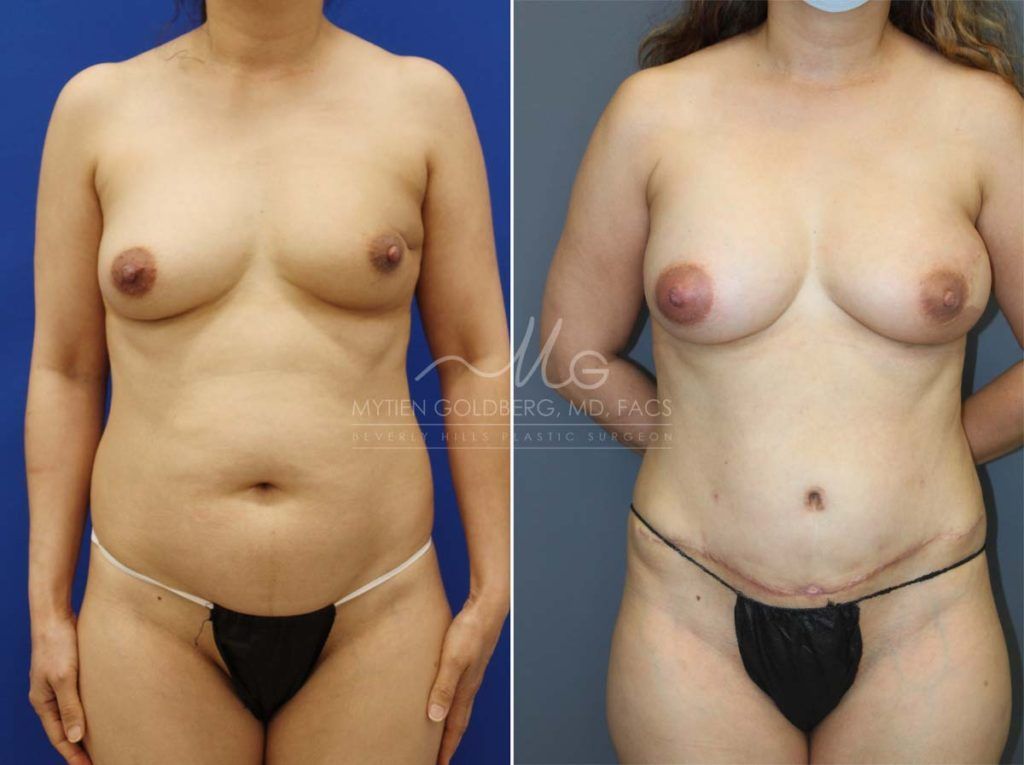
*Individual Results May Vary
CASE STUDY
DESCRIPTION:
48 year old female with history of left breast cancer. She underwent left breast cancer lumpectomy and radiation.
Patient was unhappy with the lumpectomy deformity that cause significant breast asymmetry and pain.
SURGERY:
- Left breast lumpectomy defect reconstruction with DIEP flap – using tissue from the abdomen.
- Right breast augmentation for symmetry
WHAT TO EXPECT FOLLOWING YOUR BREAST RECONSTRUCTION
Following your surgery, Dr. Goldberg and her team will provide you with detailed post-care instructions. If you have any questions regarding your recovery period, you can reach the team directly at the contact detail they provide.
After surgery, gauze or bandages will be applied to your incisions. This will minimize swelling and give additional support to the reconstructed breast(s) during your healing process. A thin tube may be placed under the skin to drain any excess fluid as you heal.
Most patients will remain in the hospital for 1 to 3 days depending on the reconstructive techniques. On average, patients may return to work at 4 weeks after a breast reconstruction.
Patients might experience discomfort and swelling in the treated area for several days after their reconstructive procedure. Pain medication can alleviate discomfort and make swelling, irritation, and bruising manageable.
Dr. Goldberg will provide clear instructions on caring for your breasts following surgery, taking medications, and looking for specific concerns. The breast reconstruction recovery process will continue for several weeks while swelling decreases and the breast shape and position settle. Patients should continue to follow recovery instructions and attend follow-up appointments.
SPECIFIC CARE
You must have an adult drive you home from the facility after your procedure. You are not allowed to drive yourself (this includes taxis and public transportation). Once home, an adult will need to stay with you for at least 24 hours from the time you are discharged from the facility, as you cannot be left alone.
- You’ll need to drink plenty of fluids to help your body remove the drugs used during surgery.
- Eating foods that are bland and low-sodium for the first 1 – 3 days following surgery might be tolerated best by your body. You must eat more than crackers and juice. Dr. Goldberg and her team can provide you with a list of foods.
- Avoid alcohol for at least the first 2 weeks and while the pain medications are being used.
- Take only medications that have been prescribed by Dr. Goldberg for your post-operative care and follow the instructions on the bottle.
DRESSINGS
- Dressings need to be kept clean and dry. Dr. Goldberg will advise you when it is okay to remove them.
PHYSICAL ACTIVITY
- Minimal activity for the first 48 hours, as this will enable your body to heal properly.
- Limit lifting, pulling, or pushing for 10 days.
- Do not put your head down below your waist if you have had facial surgery.
- You are requested to remain within a reasonable traveling distance of the office for approximately 10 days.
- Once cleared to shower you may do so.
- Please do not use the bathtub or hot tub for 4 weeks post-op.
- No smoking for the first 3 weeks post-operative as this will only delay healing.
- You may drive after all the following conditions are met: three days after anesthesia, 24 hours after the last pain pill, and when you experience no pain with activity (you need to be able to react quickly).
- Cardio workouts can be resumed (such as walking) 7 days after your surgery, but you must first be cleared by Dr. Goldberg.
SCARRING
- All surgeries involve some scarring, which can take up to 1 year to fade.
- Apply sunscreen with SPF 25 or higher to help protect the surrounding tissues.
- Scar gel can be used once the incisions are well-healed.

TYPES OF BREAST RECONSTRUCTION
One or more techniques can be used to reconstruct the breasts. These options include:
- Implant reconstruction
- Tissue expander and implant reconstruction
- Autologous flap reconstruction (using your own tissue)
- Hybrid reconstruction (tissue flap and implants)
1-STAGE IMPLANT RECONSTRUCTION: DIRECT-TO-IMPLANT
Direct-to-implant (DTI) breast reconstruction is a modern technique that completes mastectomy and breast reconstruction in one surgery. This technique involves Dr. Golberg installing a silicone gel breast implant immediately after a breast cancer surgeon performs a mastectomy to remove the breast tissue. It is common for Dr. Goldberg to use mesh products (acellular dermal matrix) to support the tissue’s regenerative process.
DTI breast reconstruction is an ideal option for those who can have mastectomies that spare the nipple and those in the early stages of breast cancer. DTI breast reconstruction is especially advantageous for a faster return to a natural body image. This is because the procedure offers simplicity and avoids multiple surgeries and recovery periods.
2-STAGE IMPLANT RECONSTRUCTION: TISSUE EXPANDER
The 2-stage breast reconstruction method uses 2 surgeries (stages) to recreate breasts after a mastectomy. In the first stage, the surgeon performing the mastectomy removes the breast tissue. During that same surgery, Dr. Goldberg will place a tissue expander (balloon-like device) into the breast pocket to create a new breast shape. This is similar to DTI reconstruction, except a tissue expander is placed initially instead of a permanent implant.
In the second stage, the tissue expander will be removed and replaced with permanent silicone breast implants.
It is common for patients to require minor adjunct procedures, such as:
- Capsulotomy (opening the capsule)
- Capsulorrhaphy (tightening of the capsule)
- Fat grafting (fat injections)
- Removal of excess skin
Breast reconstruction using the 2-stage method is ideal for patients who desire larger breasts than their original breast size. This is because the tissue expander allows for stretching of the breast skin and placement of larger implants at the final stage of the reconstruction.
PREPECTORAL IMPLANT RECONSTRUCTION TECHNIQUE
The prepectoral breast reconstruction technique can be used for 1-stage or 2-stage implant reconstruction. Traditionally, implant reconstruction involves placing the implant or tissue expander completely under the chest muscle (submuscular placement) or partially under the muscle and partially under an acellular dermal matrix (dual-plane placement). This can lead to significant pain after surgery and animation deformities.
Dr. Golberg positions the implants under the mastectomy skin flap but above the muscle, and she uses an acellular dermal matrix mesh to support the implant. This preserves the function of the pectoralis major muscle and chest wall to reduce postoperative pain.
DIEP FLAP RECONSTRUCTION
The DIEP flap method reconstructs the breast using the patient’s abdominal tissue. Skin, fat, and blood vessels (perforators) from the deep inferior epigastric perforator (DIEP) artery in the lower abdomen are moved to the chest to rebuild the breast. DIEP flap reconstruction does not cut or remove muscle, which reduces recovery time and the risk of losing abdominal muscle strength.
PAP FLAP RECONSTRUCTION
The profunda artery perforator (PAP) flap is one of the most groundbreaking breast reconstruction techniques used today. It uses skin and fat tissue from your inner thigh and the profunda artery perforator blood vessel. State-of-the-art microsurgery rebuilds the breast by reattaching the blood vessel and thigh tissue to the chest.
The PAP flap is ideal for patients who do not have enough abdominal fat for a DIEP flap. Patients who wish to have a completely natural breast reconstruction without using an implant are also good candidates for a PAP flap.
As one of the leading surgeons in reconstructive surgery, Dr. Goldberg was one of the first to offer the PAP flap to patients in Los Angeles, California. Now, it has become one of the most popular breast reconstruction procedures in her practice.
EXTENDED ABDOMEN FLAP (LOVE HANDLE TISSUE) RECONSTRUCTION
SGAP FLAP (BUTTOCK TISSUE) RECONSTRUCTION
An SGAP flap uses the superior gluteal artery perforator blood vessel and skin and fat from the upper buttocks and hips to reconstruct the breast. Dr. Goldberg uses microsurgery to meticulously reattach the blood vessels of the flap to blood vessels in your chest to promote survival of the skin and fat tissue.
The SGAP flap method is great for patients who desire a tighter, more lifted butt, as the skin and fat are removed similar to how a buttock lift is done. Good candidates for an SGAP flap are women who don’t have adequate abdominal tissue for a TRAM, DIEP, or SIEA flap. The SGAP flap leaves an inconspicuous scar near the top of your buttocks that can be easily covered by a swimsuit or underwear.
HYBRID: DIEP FLAP AND IMPLANT RECONSTRUCTION
A hybrid breast reconstruction combines a DIEP flap with a breast implant to restore volume and shape to your breast. This method offers several advantages over a strictly implant-based or tissue-based breast reconstruction. The autologous DIEP flap provides soft tissue coverage for the implant, which creates natural-looking results and reduces the risk of visible implant rippling through the skin. Also, the newly created breast size is not limited to the tissue volume produced from the donor site, as the implant can create enhanced breast volume and projection.
Candidates for hybrid breast reconstruction may have a small amount of excess abdominal tissue that can be supplemented with an implant. Those who still require radiation after mastectomy can also benefit from this procedure, as it uses healthy, non-radiated tissue from the abdomen. Dr. Goldberg is one of the few expert reconstructive surgeons in the country who offers this breast reconstruction option.
DELAYED BREAST RECONSTRUCTION
For some patients, 1-stage (immediate) breast reconstruction is performed at the same time as their mastectomy. However, a delayed breast reconstruction can be performed weeks, months, or even years after mastectomy or lumpectomy.
Patients may desire delayed reconstruction because of a medical condition, their current stage of breast cancer, or their personal lifestyle choice. Patients who undergo delayed breast reconstruction have the advantage of having additional cancer therapy without disrupting the already reconstructed breast(s).
No matter how long you wait to consider reconstructive care, it is never too late to seek breast reconstruction. Dr. Goldberg believes that every woman should have the opportunity to receive breast reconstruction that satisfies her aesthetic goals and encourages her emotional well-being.
TRANSGENDER PATIENT BREAST RECONSTRUCTION
Transgender breast reconstruction is a gender-affirming surgery designed to provide relief to patients experiencing gender dysphoria. Male to female (MTF) top surgery and female to male (FTM) top surgery are the primary categories for transgender breast procedures.
Male to female breast reconstruction provides feminization of the chest using breast reconstruction techniques. However, constructing breasts for transgender women is very different from breast augmentation in cisgender women. As a specialist, Dr. Goldberg understands the unique differences in chest anatomy and uses customized techniques to meet your aesthetic needs.

DR. GOLDBERG CAN RESTORE YOUR BREAST
BACK TO ITS FORM USING YOUR OWN TISSUE.
WHAT IS REVISION BREAST RECONSTRUCTION?
Dr. Goldberg offers breast reconstruction revision for patients who are unsatisfied with their initial breast reconstruction results. Patients may find that their breast shape, volume, or symmetry has become distorted due to breast implant or tissue flap complications.
Revision breast reconstruction may also include a capsulectomy, implant replacement, and/or additional techniques to resolve breast reconstruction complications. Revision breast reconstruction can create more attractive, satisfactory, and harmonious results than your initial reconstruction.
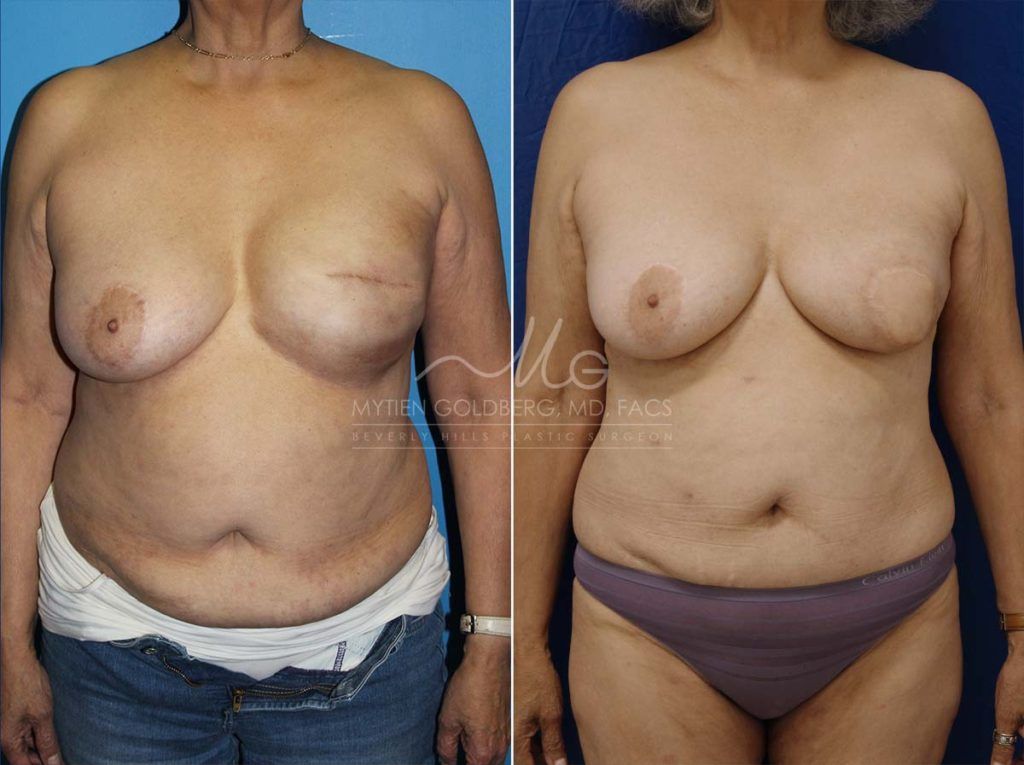
*Individual Results May Vary
CASE STUDY
DESCRIPTION:
68 year old female who presented to Dr. Goldberg for a breast reconstruction revision.
Patient was unhappy with the lumpectomy deformity that cause significant breast asymmetry and pain.
SURGERY:
Left breast implant removal. The pectoralis major muscle was placed back down on the chest. Dr. Goldberg performed a latissimus dorsi myocutaneous flap to provide new healthy tissue and placement of a new implant – Hybrid reconstruction (latissimus dorsi myocutaneous flap plus an implant).
RESULTS:
The patient is happy and her pain resolved.
BEVERLY HILLS BREAST RECONSTRUCTION & PLASTIC SURGERY: FREQUENTLY ASKED QUESTIONS
HOW MUCH DOES BREAST RECONSTRUCTION COST IN BEVERLY HILLS?
The complete cost of breast reconstruction surgery depends on the extent of the reconstruction and the technique(s) used. Breast reconstruction costs will also include additional factors such as medical imaging, facility fee, anesthesia fee, and prescription medications.
WILL MY INSURANCE COVER BREAST RECONSTRUCTION SURGERY IN BEVERLY HILLS?
Federal law
requires that health insurance companies in the United States cover breast reconstruction
costs as part of a woman’s breast cancer treatment. Whether you live in Santa Monica, Beverly Hills, West Hollywood, or anywhere in the greater Los Angeles area, Dr. Goldberg and her team will work with your insurance provider to get the best care for you.
WHAT KIND OF ANESTHESIA IS USED FOR BREAST RECONSTRUCTION IN BEVERLY HILLS?
Breast reconstruction plastic surgery is performed with general anesthesia for patient safety and comfort throughout the procedure.
AM I A CANDIDATE FOR IMMEDIATE RECONSTRUCTION IF I AM SCHEDULED TO UNDERGO CHEMOTHERAPY IN BEVERLY HILLS?
Immediate reconstruction is when breast reconstruction is performed at the same time as your mastectomy. Patients still undergoing chemotherapy, radiation therapy, or other cancer treatments will not be suitable candidates for immediate reconstruction, as these treatments might impair the healing of the reconstructed breast(s). Beverly Hills and Los Angeles patients can undergo delayed reconstruction after they finish their cancer treatments.
At Dr. Goldberg’s practice, your health and safety are a top priority. Patients might require clearance from their oncologist before proceeding with reconstructive surgery.
WILL MY BREAST RECONSTRUCTION LOOK NATURAL?
Breast reconstruction techniques are designed to look and feel as natural as possible. Breast reconstruction is performed with breast implants, flap techniques, tissue expansion, or a combination of these methods. Flap methods use donor tissue from your body, and breast implants can imitate natural tissue.
Dr. Goldberg will discuss all of your options for a natural appearance during your consultation.
IF I ONLY NEED RECONSTRUCTION ON ONE BREAST, WILL I NEED ADDITIONAL PLASTIC SURGERY ON THE OTHER?
Patients who only need to reconstruct one breast have the option to undergo cosmetic surgery on the other breast. To create a more balanced, symmetrical appearance, patients can choose to have
breast augmentation surgery,
breast reduction surgery, or
breast lift surgery on the breast opposite of the reconstructed breast.
WHAT ARE THE RISKS OF BREAST RECONSTRUCTION?
During your Beverly Hills consultation and meetings prior to surgery, Dr. Goldberg will thoroughly explain all the risks and side effects associated with breast reconstruction surgery. Patients will be asked to sign consent forms stating that they fully understand the procedure and any potential complications.
The possible risks of breast reconstruction include, but are not limited to:
- Infection
- Bleeding
- Poor incision healing
- Partial or complete loss of the flap
- Loss of sensation at the donor or reconstruction site
- Capsular contracture
- Implant rupture
DOES BREAST RECONSTRUCTION DECREASE MY CHANCES OF GETTING BREAST CANCER AGAIN? WILL IT MAKE CANCER DETECTION HARDER?
Breast reconstruction plastic surgery does not decrease your chances of breast cancer recurring or make it harder to detect if cancer does return. Your oncologist will use specialized examinations to screen for recurrence.
DOES DR. GOLDBERG HAVE BREAST RECONSTRUCTION BEFORE AND AFTER PHOTOS?
Dr. Goldberg can provide breast reconstruction before and after photographs during your consultation to help give you a better idea of similar plastic surgery treatment outcomes. Visit our
breast reconstruction photo gallery to see some of Dr. Goldberg’s patient results, including breast augmentation and double mastectomy breast reconstruction images.

